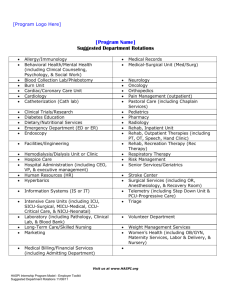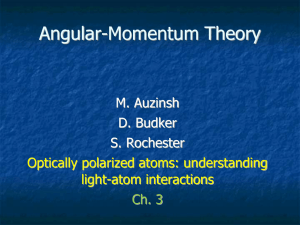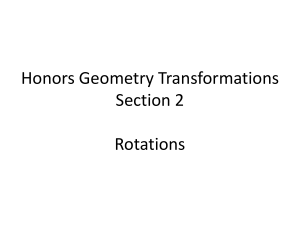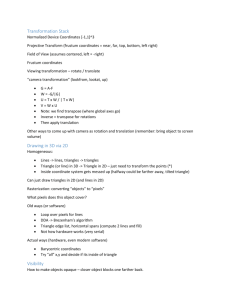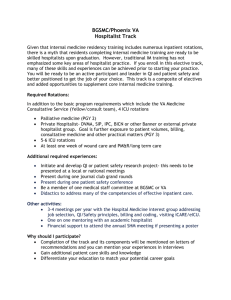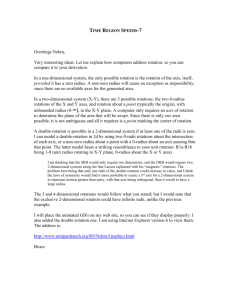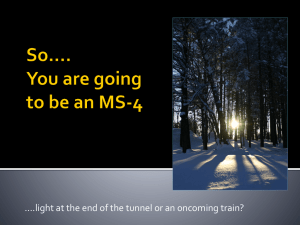Lesson 9: Sequencing Rotations
advertisement
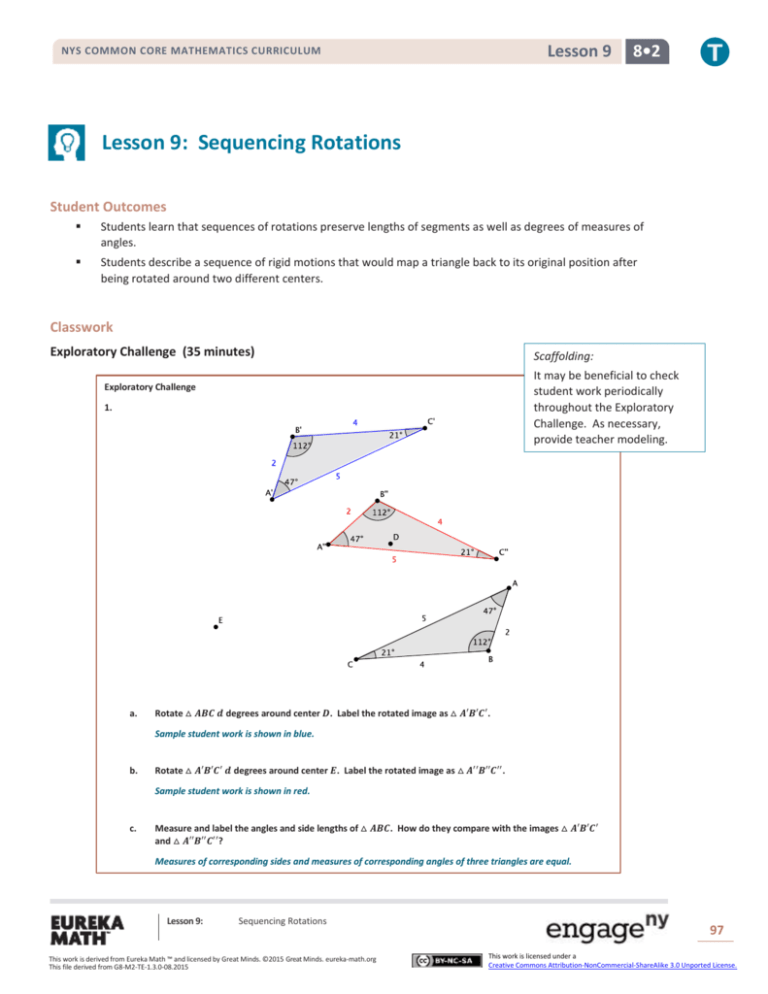
Lesson 9 NYS COMMON CORE MATHEMATICS CURRICULUM 8•2 Lesson 9: Sequencing Rotations Student Outcomes Students learn that sequences of rotations preserve lengths of segments as well as degrees of measures of angles. Students describe a sequence of rigid motions that would map a triangle back to its original position after being rotated around two different centers. Classwork Exploratory Challenge (35 minutes) Scaffolding: It may be beneficial to check student work periodically throughout the Exploratory Challenge. As necessary, provide teacher modeling. Exploratory Challenge 1. a. Rotate △ 𝑨𝑩𝑪 𝒅 degrees around center 𝑫. Label the rotated image as △ 𝑨′𝑩′𝑪′. Sample student work is shown in blue. b. Rotate △ 𝑨′𝑩′𝑪′ 𝒅 degrees around center 𝑬. Label the rotated image as △ 𝑨′′𝑩′′𝑪′′. Sample student work is shown in red. c. Measure and label the angles and side lengths of △ 𝑨𝑩𝑪. How do they compare with the images △ 𝑨′𝑩′𝑪′ and △ 𝑨′′𝑩′′𝑪′′? Measures of corresponding sides and measures of corresponding angles of three triangles are equal. Lesson 9: Sequencing Rotations This work is derived from Eureka Math ™ and licensed by Great Minds. ©2015 Great Minds. eureka-math.org This file derived from G8-M2-TE-1.3.0-08.2015 97 This work is licensed under a Creative Commons Attribution-NonCommercial-ShareAlike 3.0 Unported License. NYS COMMON CORE MATHEMATICS CURRICULUM d. Lesson 9 8•2 How can you explain what you observed in part (c)? What statement can you make about properties of sequences of rotations as they relate to a single rotation? We already knew that a single rotation would preserve the lengths of segments and degrees of angles. Performing one rotation after the other does not change the lengths of segments or degrees of angles. That means that sequences of rotations enjoy the same properties as a single rotation. 2. a. Rotate △ 𝑨𝑩𝑪 𝒅 degrees around center 𝑫, and then rotate again 𝒅 degrees around center 𝑬. Label the image as △ 𝑨′𝑩′𝑪′ after you have completed both rotations. Possible student solution is shown in diagram as △ 𝑨′ 𝑩′ 𝑪′ . b. Can a single rotation around center 𝑫 map △ 𝑨′𝑩′𝑪′ onto △ 𝑨𝑩𝑪? No, a single rotation around center 𝑫 will not map △ 𝑨′𝑩′𝑪′ onto △ 𝑨𝑩𝑪. c. Can a single rotation around center 𝑬 map △ 𝑨′𝑩′𝑪′ onto △ 𝑨𝑩𝑪? No, a single rotation around center 𝑬 will not map △ 𝑨′𝑩′𝑪′ onto △ 𝑨𝑩𝑪. d. Can you find a center that would map △ 𝑨′𝑩′𝑪′ onto △ 𝑨𝑩𝑪 in one rotation? If so, label the center 𝑭. Yes, a 𝒅-degree rotation around center 𝑭 will map △ 𝑨′𝑩′𝑪′ onto △ 𝑨𝑩𝑪. Note: Students can only find the center 𝐹 through trial and error at this point. Finding the center of rotation for two congruent figures is a skill that will be formalized in high school Geometry. Lesson 9: Sequencing Rotations This work is derived from Eureka Math ™ and licensed by Great Minds. ©2015 Great Minds. eureka-math.org This file derived from G8-M2-TE-1.3.0-08.2015 98 This work is licensed under a Creative Commons Attribution-NonCommercial-ShareAlike 3.0 Unported License. NYS COMMON CORE MATHEMATICS CURRICULUM Lesson 9 8•2 3. a. Rotate △ 𝑨𝑩𝑪 𝟗𝟎° (counterclockwise) around center 𝑫, and then rotate the image another 𝟗𝟎° (counterclockwise) around center 𝑬. Label the image △ 𝑨′ 𝑩′ 𝑪′ . Sample student work is shown in blue. b. Rotate △ 𝑨𝑩𝑪 𝟗𝟎° (counterclockwise) around center 𝑬, and then rotate the image another 𝟗𝟎° (counterclockwise) around center 𝑫. Label the image △ 𝑨′′𝑩′′𝑪′′. Sample student work is shown in red. c. What do you notice about the locations of △ 𝑨′𝑩′𝑪′ and △ 𝑨′′𝑩′′𝑪′′? Does the order in which you rotate a figure around different centers have an impact on the final location of the figure’s image? The triangles are in two different locations. Yes, the order in which we rotate a figure around two different centers must matter because the triangles are not in the same location after rotating around center 𝑫 and then center 𝑬 compared to rotating around center 𝑬 and then center 𝑫. Lesson 9: Sequencing Rotations This work is derived from Eureka Math ™ and licensed by Great Minds. ©2015 Great Minds. eureka-math.org This file derived from G8-M2-TE-1.3.0-08.2015 99 This work is licensed under a Creative Commons Attribution-NonCommercial-ShareAlike 3.0 Unported License. NYS COMMON CORE MATHEMATICS CURRICULUM Lesson 9 8•2 4. a. Rotate △ 𝑨𝑩𝑪 𝟗𝟎° (counterclockwise) around center 𝑫, and then rotate the image another 𝟒𝟓° (counterclockwise) around center 𝑫. Label the image △ 𝑨′ 𝑩′ 𝑪′ . Rotated triangle is shown above. b. Rotate △ 𝑨𝑩𝑪 𝟒𝟓° (counterclockwise) around center 𝑫, and then rotate the image another 𝟗𝟎° (counterclockwise) around center 𝑫. Label the image △ 𝑨′′𝑩′′𝑪′′. Rotated triangle is shown above. c. What do you notice about the locations of △ 𝑨′𝑩′𝑪′ and △ 𝑨′′𝑩′′𝑪′′? Does the order in which you rotate a figure around the same center have an impact on the final location of the figure’s image? The triangles are in the same location. This indicates that when a figure is rotated twice around the same center, it does not matter in which order you perform the rotations. 5. △ 𝑨𝑩𝑪 has been rotated around two different centers, and its image is △ 𝑨′ 𝑩′ 𝑪′ . Describe a sequence of rigid motions that would map △ 𝑨𝑩𝑪 onto △ 𝑨′𝑩′𝑪′. ⃗⃗⃗⃗⃗⃗ . Then, rotate △ 𝑨𝑩𝑪 around point 𝑪′ until △ 𝑨𝑩𝑪 maps onto △ 𝑨′ 𝑩′ 𝑪′ . Translate △ 𝑨𝑩𝑪 along vector 𝑪𝑪′ Lesson 9: Sequencing Rotations This work is derived from Eureka Math ™ and licensed by Great Minds. ©2015 Great Minds. eureka-math.org This file derived from G8-M2-TE-1.3.0-08.2015 100 This work is licensed under a Creative Commons Attribution-NonCommercial-ShareAlike 3.0 Unported License. NYS COMMON CORE MATHEMATICS CURRICULUM Lesson 9 8•2 Closing (5 minutes) Summarize, or have students summarize, the lesson. Sequences of rotations enjoy the same properties as single rotations. That is, a sequence of rotations preserves lengths of segments and degrees of measures of angles. The order in which a sequence of rotations around two different centers is performed matters. The order in which a sequence of rotations around the same center is performed does not matter. When a figure is rotated around two different centers, we can describe a sequence of rigid motions that would map the original figure onto the resulting image. Lesson Summary Sequences of rotations have the same properties as a single rotation: A sequence of rotations preserves degrees of measures of angles. A sequence of rotations preserves lengths of segments. The order in which a sequence of rotations around different centers is performed matters with respect to the final location of the image of the figure that is rotated. The order in which a sequence of rotations around the same center is performed does not matter. The image of the figure will be in the same location. Exit Ticket (5 minutes) Lesson 9: Sequencing Rotations This work is derived from Eureka Math ™ and licensed by Great Minds. ©2015 Great Minds. eureka-math.org This file derived from G8-M2-TE-1.3.0-08.2015 101 This work is licensed under a Creative Commons Attribution-NonCommercial-ShareAlike 3.0 Unported License. Lesson 9 NYS COMMON CORE MATHEMATICS CURRICULUM Name 8•2 Date Lesson 9: Sequencing Rotations Exit Ticket 1. Let 𝑅𝑜𝑡𝑎𝑡𝑖𝑜𝑛1 be the rotation of a figure 𝑑 degrees around center 𝑂. Let 𝑅𝑜𝑡𝑎𝑡𝑖𝑜𝑛2 be the rotation of the same figure 𝑑 degrees around center 𝑃. Does the 𝑅𝑜𝑡𝑎𝑡𝑖𝑜𝑛1 of the figure followed by the 𝑅𝑜𝑡𝑎𝑡𝑖𝑜𝑛2 equal a 𝑅𝑜𝑡𝑎𝑡𝑖𝑜𝑛2 of the figure followed by the 𝑅𝑜𝑡𝑎𝑡𝑖𝑜𝑛1 ? Draw a picture if necessary. 2. Angle 𝐴𝐵𝐶 underwent a sequence of rotations. The original size of ∠𝐴𝐵𝐶 Is 37°. What was the size of the angle after the sequence of rotations? Explain. 3. Triangle 𝐴𝐵𝐶 underwent a sequence of rotations around two different centers. Its image is △ 𝐴′ 𝐵′ 𝐶 ′ . Describe a sequence of rigid motions that would map △ 𝐴𝐵𝐶 onto △ 𝐴′ 𝐵′ 𝐶 ′ . Lesson 9: Sequencing Rotations This work is derived from Eureka Math ™ and licensed by Great Minds. ©2015 Great Minds. eureka-math.org This file derived from G8-M2-TE-1.3.0-08.2015 102 This work is licensed under a Creative Commons Attribution-NonCommercial-ShareAlike 3.0 Unported License. NYS COMMON CORE MATHEMATICS CURRICULUM Lesson 9 8•2 Exit Ticket Sample Solutions 1. Let 𝑹𝒐𝒕𝒂𝒕𝒊𝒐𝒏𝟏 be the rotation of a figure 𝒅 degrees around center 𝑶. Let 𝑹𝒐𝒕𝒂𝒕𝒊𝒐𝒏𝟐 be the rotation of the same figure 𝒅 degrees around center 𝑷. Does the 𝑹𝒐𝒕𝒂𝒕𝒊𝒐𝒏𝟏 of the figure followed by the 𝑹𝒐𝒕𝒂𝒕𝒊𝒐𝒏𝟐 equal a 𝑹𝒐𝒕𝒂𝒕𝒊𝒐𝒏𝟐 of the figure followed by the 𝑹𝒐𝒕𝒂𝒕𝒊𝒐𝒏𝟏 ? Draw a picture if necessary. No. If the sequence of rotations were around the same center, then it would be true. However, when the sequence involves two different centers, the order in which they are performed matters because the images are not in the same location in the plane. 2. Angle 𝑨𝑩𝑪 underwent a sequence of rotations. The original size of ∠𝑨𝑩𝑪 is 𝟑𝟕°. What was the size of the angle after the sequence of rotations? Explain. Since sequences of rotations enjoy the same properties as a single rotation, then the measure of any image of ∠𝑨𝑩𝑪 under any sequence of rotations remains 𝟑𝟕°. Rotations and sequences of rotations preserve the measure of degrees of angles. 3. Triangle 𝑨𝑩𝑪 underwent a sequence of rotations around two different centers. Its image is △ 𝑨′ 𝑩′ 𝑪′ . Describe a sequence of rigid motions that would map △ 𝑨𝑩𝑪 onto △ 𝑨′ 𝑩′ 𝑪′ . Translate △ 𝑨𝑩𝑪 along vector ⃗⃗⃗⃗⃗⃗⃗ 𝑩𝑩′. Then, rotate △ 𝑨𝑩𝑪 𝒅 degrees around point 𝑩′ until △ 𝑨𝑩𝑪 maps onto △ 𝑨′ 𝑩′ 𝑪′ . Lesson 9: Sequencing Rotations This work is derived from Eureka Math ™ and licensed by Great Minds. ©2015 Great Minds. eureka-math.org This file derived from G8-M2-TE-1.3.0-08.2015 103 This work is licensed under a Creative Commons Attribution-NonCommercial-ShareAlike 3.0 Unported License. Lesson 9 NYS COMMON CORE MATHEMATICS CURRICULUM 8•2 Problem Set Sample Solutions 1. Refer to the figure below. a. Rotate ∠𝑨𝑩𝑪 and segment 𝑫𝑬 𝒅 degrees around center 𝑭 and then 𝒅 degrees around center 𝑮. Label the final location of the images as ∠𝑨′𝑩′𝑪′ and segment 𝑫′𝑬′. b. What is the size of ∠𝑨𝑩𝑪, and how does it compare to the size of ∠𝑨′ 𝑩′ 𝑪′ ? Explain. The measure of ∠𝑨𝑩𝑪. Is 𝟒𝟔°. The measure of ∠𝑨′ 𝑩′ 𝑪′ is 𝟒𝟔°. The angles are equal in measure because a sequence of rotations preserves the degrees of an angle. c. What is the length of segment 𝑫𝑬, and how does it compare to the length of segment 𝑫′𝑬′? Explain. The length of segment 𝑫𝑬 is 𝟒 𝐜𝐦. The length of segment 𝑫′𝑬′ is also 𝟒 𝐜𝐦. The segments are equal in length because a sequence of rotations preserves the length of segments. 2. Refer to the figure given below. a. Let 𝑹𝒐𝒕𝒂𝒕𝒊𝒐𝒏𝟏 be a counterclockwise rotation of 𝟗𝟎° around the center 𝑶. Let 𝑹𝒐𝒕𝒂𝒕𝒊𝒐𝒏𝟐 be a clockwise rotation of (−𝟒𝟓)° around the center 𝑸. Determine the approximate location of 𝑹𝒐𝒕𝒂𝒕𝒊𝒐𝒏𝟏 (△ 𝑨𝑩𝑪) followed by 𝑹𝒐𝒕𝒂𝒕𝒊𝒐𝒏𝟐 . Label the image of △ 𝑨𝑩𝑪 as △ 𝑨′𝑩′𝑪′. Lesson 9: Sequencing Rotations This work is derived from Eureka Math ™ and licensed by Great Minds. ©2015 Great Minds. eureka-math.org This file derived from G8-M2-TE-1.3.0-08.2015 104 This work is licensed under a Creative Commons Attribution-NonCommercial-ShareAlike 3.0 Unported License. NYS COMMON CORE MATHEMATICS CURRICULUM b. Lesson 9 8•2 Describe the sequence of rigid motions that would map △ 𝑨𝑩𝑪 onto △ 𝑨′ 𝑩′ 𝑪′ . The image of △ 𝑨𝑩𝑪 is shown above. Translate △ 𝑨𝑩𝑪 along vector ⃗⃗⃗⃗⃗⃗⃗ 𝑨𝑨′. Rotate △ 𝑨𝑩𝑪 𝒅 degrees around center 𝑨′. Then, △ 𝑨𝑩𝑪 will map onto △ 𝑨′𝑩′𝑪′. 3. Refer to the figure given below. Let 𝑹 be a rotation of (−𝟗𝟎)° around the center 𝑶. Let 𝑹𝒐𝒕𝒂𝒕𝒊𝒐𝒏𝟐 be a rotation of (−𝟒𝟓)° around the same center 𝑶. Determine the approximate location of 𝑹𝒐𝒕𝒂𝒕𝒊𝒐𝒏𝟏 (△ 𝑨𝑩𝑪) followed by 𝑹𝒐𝒕𝒂𝒕𝒊𝒐𝒏𝟐 (△ 𝑨𝑩𝑪). Label the image of △ 𝑨𝑩𝑪 as △ 𝑨′𝑩′𝑪′. The image of △ 𝑨𝑩𝑪 is shown above. Lesson 9: Sequencing Rotations This work is derived from Eureka Math ™ and licensed by Great Minds. ©2015 Great Minds. eureka-math.org This file derived from G8-M2-TE-1.3.0-08.2015 105 This work is licensed under a Creative Commons Attribution-NonCommercial-ShareAlike 3.0 Unported License.
